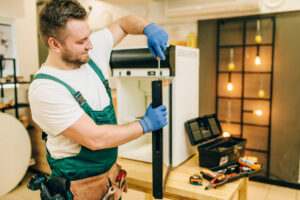Sometimes the smallest things can cause the biggest problems.
Take, for example, your refrigerator. It’s one of those tiny problems that can lead to a lot of damage and inconvenience.
If you smell musty or stinky odors coming from your fridge and opening it reveals a pool of water on the bottom or on the floor, that’s a surefire sign you’re dealing with a leak in your fridge — one that’s likely to get worse if left ignored.
Is it the drain pan?
If your refrigerator has a bottom drain pan under it, this is where most leaks occur.
The pan should be made of stainless steel or plastic and should have several small holes in it to allow any water that spills into it to drain away from the unit.
If the pan is full of water or if you see any standing water around the base of your refrigerator, it’s likely that you have a leak somewhere on or near the floor under your fridge.
Check the door seal
Check the door seal of your fridge if it is leaking water.
If the seal is torn or damaged, you may need to replace it. Open both doors on your refrigerator and look at the bottom of each door for screws or bolts.
Loosen these screws with a screwdriver and remove them completely from their holes on both sides of the door.
This will allow one end of each door to be removed from its hinge on one side only so you will have access to both sides of your seal when replacing it later on in this project.
Figure out which compartment is leaking, and find its drain hole
You’ll need to pull out all of your food and other items before you can do this. Here’s how:
If it’s coming from the ice maker or water dispenser, look for a hole on the bottom of these compartments.
It will be covered with a rubber plug when not in use; simply pull it off to find the hole underneath.
If it’s coming from inside one of your drawers or shelves, look for a small hole in an upper corner near where it connects to the wall cavity — sometimes there are two holes there; one drains into a pan under your refrigerator while the other goes straight down through the floor into your basement or crawl space (or directly outside if you have an outdoor vent). If you don’t see any holes in these areas, then there may be another problem causing them to leak.
Find out where your condensate drain hose goes
Another thing to do is find out where your condensate drain hose goes.
This is the tube that drains water from inside the refrigerator into a bucket or sink.
If you have a side-by-side refrigerator or french door model, there may be two hoses; one for each side of the refrigerator. If you have an older top-freezer model, there will be just one hose draining into a bucket or sink under the unit.
If you don’t know where your condensate drain hose goes, unplug your refrigerator and pull it away from the wall or baseboard until it’s easy for you to see behind it.
The condensate pipe should be running along the rear wall from underneath your refrigerator down towards an empty bucket or sink placed underneath it.
If there’s no bucket or sink under there, check under your kitchen sink or bathroom vanity — if there’s an empty tray under either of these places then that’s where you should put your bucket.
Take a look at the condenser coil
The condenser coil is the part of your refrigerator that gets warm and collects water. Sometimes this coil can become blocked with dust or lint, which can cause your refrigerator to leak.
This can be frustrating, but it’s not hard to fix.
The first thing you should do if your fridge is leaking is take a look at the condenser coil.
You’ll find it on the back wall of your fridge (usually behind an access panel). It’s usually a black plastic tube with a fan inside blowing air over it. If it’s dirty, you can use some compressed air to blow out any dust or lint.
If that doesn’t solve the problem, there may be something blocking the drain line. Check to see if there are any kinks in the line — if so, try straightening them out.
You can also turn off the water supply valve under your sink and flush out any debris that might have collected inside (you might need to do this several times before seeing results).
When you’re experiencing a leak from your refrigerator, the first instinct is probably to get rid of it and start over.
But before you do that, give these suggestions a try—you might just find that your fridge can be fixed without having to go buy a new one.



